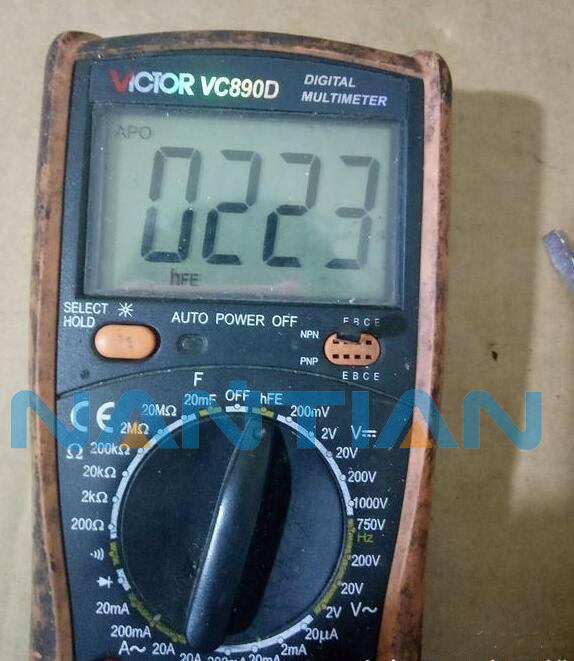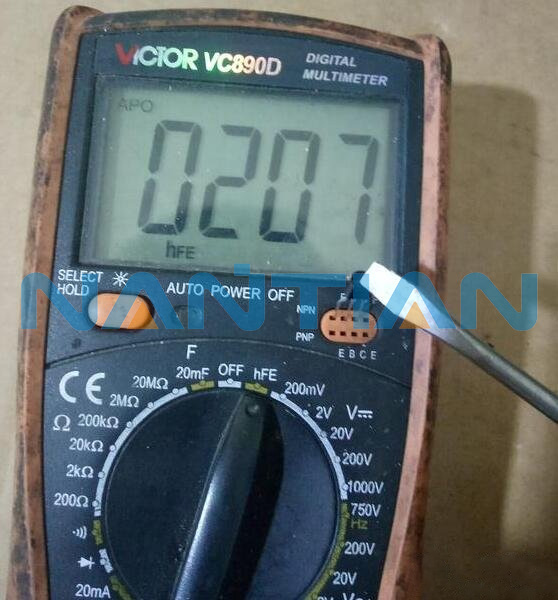
In the complex world of electronics, transistors play a key role as fundamental building blocks. A key parameter that significantly affects its functionality is hFE or beta (β). This article aims to delve deeper into the concept of hFE in transistors, exploring its definition, significance and how it affects the overall performance of electronic circuits. After you understand what hFE is, we will also teach you how to calculate the hFE value of a transistor and how to easily measure the hFE of a transistor with a multimeter.
What is transistor hFE?
The term "hFE" in transistors refers to the forward current gain when the transistor is in a common emitter configuration. Also known as beta (β) or simply the current gain, hFE is defined as the ratio of output current (collector current, IC) to input current (base current, IB), expressed mathematically as hFE = IC/IB.

NPN and PNP transistor current direction
The transistor is a device that detects the base current to control the collector current. The larger the value of hFE or β, the better, indicating strong amplification capability because it can control a larger current with a smaller current. However, the amplification factor of small-signal transistors is usually about one hundred to hundreds, and that of power amplifier tubes is about tens to one hundred. However, it should be noted that even for transistors of the same model, the hFE value is dispersed, so most transistors are divided into grades based on the size of the current amplification coefficient, except for high-frequency tubes and some that have little to do with the hFE value.
The role of hFE in transistors
The hFE of transistor, or forward current gain in common emitter configuration, plays a significant role in the functioning of transistors. Here are some key areas where it is important:
Signal Amplification: The primary function of a transistor is to amplify signals. The hFE value represents the amplification factor of the transistor - how much it can amplify an input signal.
Circuit Design: When designing circuits that use transistors, understanding and considering the hFE values can help determine other component values (like base resistors) for desired operation.
Switching Applications: In switching applications like digital logic or driving motors/relays/etc., you need to ensure that your transistor fully turns on/off with your control signal's strength (base current). Knowing the minimum hFE helps calculate if your base drive will be enough.
Biasing Transistor: For proper operation and stability over temperature variations, biasing schemes often rely on knowing transistor parameters like hFE.
However, as mentioned earlier, relying solely on specific h_FE values may not yield consistent results due to its variability between different transistors—even those of identical type—and changes with conditions such as temperature and collector-emitter voltage.
In many designs for robustness and predictability especially at scale production levels, designers try not to depend too heavily upon exact hFE values but design in a way that even with variation in hFE value circuit performs consistently.
What are the factors that affect transistor hFE?
The hFE (or β) of a transistor, which is the forward current gain in common emitter configuration, can be affected by several factors:
Temperature: The value of hFE tends to decrease as temperature increases. This is due to an increase in minority carrier concentrations with temperature.
Collector Current (Ic): The value of hFE also varies with collector current. It generally increases initially with Ic but after reaching a peak starts decreasing again.
Manufacturing Variations: Even among identical models from the same manufacturer, there can be noticeable variations in hFE due to differences that arise during manufacturing processes.
Collector-Emitter Voltage (Vce): Vce can also affect the hFE, although this effect is usually less significant than those mentioned above.
Frequency: At high frequencies, the transit time for carriers becomes comparable or longer than signal period and hence transistor cannot fully respond leading to lower effective gain i.e., reduction in hFE at higher frequencies
Ageing/Wear-out mechanisms: Over long periods of usage under various stress conditions like high voltage/current/temperature etc., physical degradation mechanisms within semiconductor device might lead to changes in device parameters including hFE
Given these factors that influence its value significantly and unpredictably it's often considered good design practice not overly depend on exact hFE values but rather design circuits such that they function predictably even over wide range of possible hFE values.
How to Calculate hFE of a Transistor?
The hFE (also known as β or beta) of a transistor is the forward current gain in common emitter configuration. It's defined as the ratio between the output collector current (IC) and the input base current (IB).

PNP and NPN transistor output(IC) and input(IB) current direction
You can calculate it using this formula:
To measure and , you would typically set up a test circuit where you can control and measure these currents.
Measure Base Current (): Connect a known resistance to the base of your transistor, then apply a known voltage across that resistor. You can calculate IB by dividing that voltage by your resistance (using Ohm's law).
Measure Collector Current (): Connect another known resistor to your collector, then measure the voltage drop across it while your transistor is "on". Again, you can use Ohm's law to find IC.
Then plug those values into our formula above.
Remember, however, that hFE varies with temperature, from device to device even for same part numbers due its manufacturing process variability ,and also changes significantly with different levels of Ic itself so this should be kept in mind when designing circuits based on hFE value.
How do you check hFE with a multimeter?
First find the electrodes corresponding to the three pins of the transistor, emitter E, collector C, and base B. Let me use the commonly used switching transistor 8050 as an example to show you that this transistor is of NPN type, facing the plane, and the pins are E, B, and C in order. Set the multimeter to the hFE position, insert it into the hole of the digital multimeter according to the corresponding value, and read the value. Below is the triode of the same model that I measured, please see the picture below.

Measuring switching transistor 8050

Measure another switching transistor 8050
Although the two measurements are of the same transistor model, the results of the two measurements are different. The multimeter measured the hFE of the first 8050 transistor to be 0223 and the hFE of the other 8050 transistor to be 0207. Two transistors of the same model have different hFE values, which fully verifies the dispersion of hFE values as mentioned above.
Summary
In conclusion, the hFE parameter of a transistor, also known as beta (β), is defined as the ratio of output current (IC) to input current (IB). It allows us to understand the current amplification capabilities of a transistor. Importantly, hFE is not constant. Due to factors such as temperature changes, variations in collector-emitter voltage or collector current, manufacturing differences between transistors, frequency response characteristics and even long-term aging effects can cause significant variances in transistor hFE.
FAQ
1. What is hFE in a transistor and why it is also referred to as beta (β)?
hFE, also known as beta (β), refers to the forward current gain when a transistor operates in its common emitter configuration. It's defined as the ratio of output current (collector current, IC) to input current (base current, IB). In other words, it gives an estimate of how much a signal will be amplified by the transistor.
2. How does hFE affect the operation of a transistor?
The value of hFE affects how much an input signal gets amplified by a transistor. A higher hFE means more amplification and vice versa.
3. Why isn't the value of hFE constant??
The value of hFE can vary due to several factors such as temperature changes or differences between individual transistors even within same model types due manufacturing variations.
4. What factors can cause variations in hFE?
Factors that can cause variation in hFE include temperature changes, frequency response characteristics, long-term aging effects on components and discrepancies during manufacturing process among different batches or units.
5. How do changes in temperature influence the hFE of a transistor?
Generally speaking, increases in temperature tend to decrease both collector-to-emitter breakdown voltage and base-to-emitter turn-on voltage but increase leakage currents which could alter effective β values.
6. How do manufacturing differences between transistors impact their respective hFE values?
Even minor deviations during fabrication processes like doping concentrations or layer thicknesses may lead each unit having slightly different electrical properties including β-value.
7. How do changes in temperature influence the hFE of a transistor?
While collector current(IC) represents actual output flow from device under certain conditions; hFE or β describes ratio between this output (IC) versus required input at base terminal (IB). Hence they represent two distinct aspects about its functioning: one being raw performance metric while another providing insight into efficiency/transfer capability.
8. What is hFE on multimeter ?
The hFE on the multimeter represents the multimeter's built-in transistor testing function. When the multimeter's range is selected as hFE, inserting the transistor lead into the corresponding socket can be used to directly measure the approximate β value.